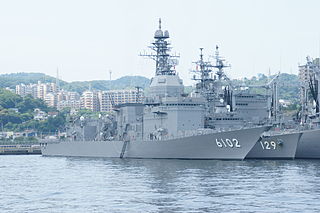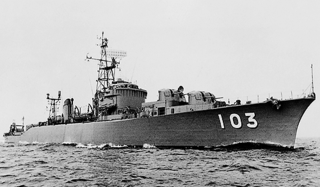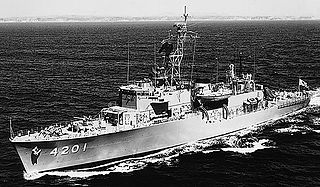
JS Kurama (DDH-144) was the second ship of the Shirane-class destroyer in service with the Japan Maritime Self-Defense Force (JMSDF).

JDS Yukikaze (DD-102) was the second ship of Harukaze-class destroyers, and the second destroyer of the Japanese Maritime Self Defense Force to be built in Japan since the end of World War II.

JS Chihaya (ASR-403) is a submarine rescue ship of Japan Maritime Self-Defense Force.

JS Kurobe (ATS-4202) is a training support ship of Japan Maritime Self-Defense Force.

JS Tenryū (ATS-4203) is a training support ship of Japan Maritime Self-Defense Force.

JDS Fushimi (ASR-402) was a submarine rescue ship of Japan Maritime Self-Defense Force.

JS Asuka (ASE-6102) is an experimental ship of the Japan Maritime Self-Defense Force. The vessel was constructed by Sumitomo Heavy Industries of Tokyo, Japan and was launched on 21 June 1994. Asuka was commissioned on 22 March 1995 and since then has conducted performance confirmation tests for integrated navigation systems.

JS Asayuki (DD-132) was a Hatsuyuki-class destroyer of the Japanese Maritime Self-Defense Force.

JDS Aokumo (DD-119) was the fourth ship of Yamagumo-class destroyers.

JDS Ayanami (DD-103) was the lead ship of Ayanami-class destroyers.

JDS Isonami (DD-104) was the second ship of Ayanami-class destroyers.

JDS Hayase (MST-462) was a minesweeper for the Japan Maritime Self-Defense Force.

The Futami class was a class of oceanographic research ship of Japan Maritime Self-Defense Force (JMSDF) in the late 1970s.

JS Nichinan (AGS-5105) is the only ship of her type of oceanographic research ship for the Japan Maritime Self-Defense Force.

JS Shōnan (AGS-5106) is the only ship of her type of oceanographic research ship for the Japan Maritime Self-Defense Force.

JDSAkashi(AGS-5101) was an oceanographic research ship of Japan Maritime Self-Defense Force (JMSDF) in the late 1960s.

JDSSōya(MMC-951) was an minelayer of Japan Maritime Self-Defense Force (JMSDF) in the early 1970s.

The Mine Warfare Force belonged to the minesweeping force for the self-defense fleet of the Maritime Self-Defense Forces. Its main task is to lay naval mines in the event of an emergency, and it also help to dispose mines installed during World War II.

JDS Azuma (ATS-4201) is a training support ship of Japan Maritime Self-Defense Force. JS Kurobe was built in 1989 for the purpose of training that cannot be handled by Azuma's equipments, and so she was removed from the register in 1999 when the new training ship Tenryu was built.

JDSHayabusa(PC-308) was a submarine chaser of the Japan Maritime Self-Defense Force (JMSDF) in the mid-1950s. She was later converted to an accommodation ship and redesignated as ASY-91. She was the third vessel to inherit the name after the Imperial Japanese Navy's Hayabusa-class torpedo boat Hayabusa and Ōtori-class torpedo boat Hayabusa.






















